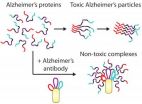(Press-News.org) Scientists from VIB and KU Leuven have discovered a new target molecule for the development of a treatment against Alzheimer's disease. There is currently no cure for this disease. Many candidate drugs fail because they also target proteins essential to life. This discovery from Leuven could form a target for a treatment against Alzheimer's disease with fewer side effects and that suppresses the very first symptoms of the disease. This research will be published in the leading journal Nature Medicine.
Alzheimer's Disease
Alzheimer's Disease is the most common form of dementia in the West. The damage to memory and mental function causes one of the most terrifying clinical pictures. The current drugs for Alzheimer patients support memory for a short time, but they do not stop the death of brain cells. Recent insights have shown that Alzheimer's disease causes biochemical changes in the brain many years before the symptoms of dementia are present. It is very important to develop drugs that can be taken at this early stage in order to prevent the disease.
The ɣ-secretase complex
Many candidate drugs have an effect on the ɣ-secretase complex. This complex cuts proteins at specific sites and plays an important role in the development of amyloid plaques, a pathological hallmark in of the brains of Alzheimer patients. Aberrant and excessive cleavage of the amyloid precursor protein by the y-secretase complex results in the accumulation and deposition of the β-amyloid protein in amyloid plaques.
However, the ɣ-secretase complex is also involved in cleavage of a series of other proteins essential to life. As a result, many candidate drugs that act on the ɣ-secretase complex produce toxic side effects.
GPCRs and β-arrestin
GPCRs are a family of proteins that serve as the targets of the majority of all currently marketed drugs. The Nobel Prize in Chemistry for 2012 was awarded to Dr. Robert Lefkowitz and Dr. Brian Kobilka for their groundbreaking work in this field and the many medical applications of this knowledge. It is known that GPCRs also play a role in the development of Alzheimer's disease, but it is not yet clear how GPCRs regulate the ɣ-secretase complex.
β-arrestins are a family of proteins that classically block or limit GPCR activation; however, it has been recently appreciated that β-arrestins also have additional functions. Therefore, Amantha Thathiah set up a study under the supervision of Bart De Strooper to examine the involvement of β-arrestins in the development of Alzheimer's disease.
The scientists succeeded for the first time in demonstrating that β-arrestin 2 plays a role in regulation of the ɣ-secretase complex function and in the development of Alzheimer's disease in an Alzheimer's disease mouse model. More specifically, β-arrestin 2 interacts with two GPCRs that are known to play a role in the development of Alzheimer's disease. Moreover, expression of β-arrestin 2 is also elevated in individuals with Alzheimer's disease.
Impact of the research
This research opens a new pathway for the treatment of Alzheimer's disease. β-arrestin 2 inhibition could be beneficial in prevention of the adverse side effects currently associated with γ-secretase inhibition. Therefore, this study provides a previously unexplored avenue for the development of a treatment that can act at a very early stage of Alzheimer's disease.
###
Questions
Given that this research can raise many questions of patients, we would like to refer you to the email address that VIB makes available for this purpose. Anyone can submit questions concerning this and other medically oriented research to patienteninfo@vib.be.
Relevant scientific publication
This research will be published in the leading journal Nature Medicine, Thathiah et al., β-arrestin 2 regulates Aβ generation and γ-secretase activity in Alzheimer's disease
Study team
This research was performed in the research group of Bart De Strooper in the VIB Research Centre for Developmental Mechanisms of Diseases, KU Leuven
Funding
This research was funded by VIB, MNIRG from the Alzheimer's Association, the Fund for Scientific Research Flanders, K.U. Leuven, a Methusalem grant from the K.U. Leuven and the Flemish government, the foundation for Alzheimer Research (SAO/FRMA).
Leuven research opens new pathway for the treatment of Alzheimer's disease
2012-12-03
ELSE PRESS RELEASES FROM THIS DATE:
Uncovering unique properties in a 2-dimensional crystal
2012-12-03
When the dry lubricant, molybdenum disulfide, is stripped down to a single layer of atoms, a tightly bound quasi-particle comprised of two electrons and a hole forms with unique spin and valley properties, researchers from Case Western Reserve University and colleagues discovered.
These charged quasi-particles, called negative trions, can be manipulated to change the light absorbed and emitted from this two-dimensional semi-conducting crystal, opening it to potential use in new solar cells and other electronic devices that are controlled by light or designed to control ...
Sharp spike in computer-related injuries predicted for medical workers, find studies
2012-12-03
ITHACA, N.Y. – As U.S. health care goes high tech, spurred by $20 billion in federal stimulus incentives, the widespread adoption of electronic medical records and related digital technologies is predicted to reduce errors and lower costs – but it is also likely to significantly boost musculoskeletal injuries among doctors and nurses, concludes a Cornell University ergonomics professor in two new papers.
The repetitive strain injuries, he said, will stem from poor office layouts and improper use of computer devices.
"Many hospitals are investing heavily in new technology ...
Cancer screening: The efficacy of mammography screening
2012-12-03
How effective is the German mammography screening program? This is the question examined by Oliver Heidinger of the Epidemiological Cancer Registry North Rhine–Westphalia and his co-authors in the first study on this subject in Germany, in Deutsches Ärzteblatt International (Dtsch Arztebl Int 2012; 109(46): 781-7).
To answer it, the authors have used the interval cancer rate as an indicator. Interval cancers are tumors found more or less by chance between two screenings. In approximately 880 000 women from North Rhine–Westphalia who had taken part in mammography screening ...
New 'pipeline' device offers new option for difficult-to-treat aneurysms
2012-12-03
Philadelphia, Pa. (December 3, 2012) – A new technology called the Pipeline embolization device (PED) shows encouraging results in patients with certain types of difficult-to-treat brain aneurysms, reports the December issue of Neurosurgery, official journal of the Congress of Neurological Surgeons. The journal is published by Lippincott Williams & Wilkins, a part of Wolters Kluwer Health.
Data collected since the PED was approved for marketing show generally good results in "real world" clinical practice. However, the report raises concerns about fatal bleeding and other ...
Novel antibodies for combating Alzheimer's and Parkinson's disease
2012-12-03
Troy, N.Y. – Antibodies developed by researchers at Rensselaer Polytechnic Institute are unusually effective at preventing the formation of toxic protein particles linked to Alzheimer's disease and Parkinson's disease, as well as Type 2 diabetes, according to a new study.
The onset of these devastating diseases is associated with the inappropriate clumping of proteins into particles that are harmful to cells in the brain (Alzheimer's disease and Parkinson's disease) and pancreas (Type 2 diabetes). Antibodies, which are commonly used by the immune system to target foreign ...
Awareness is key to preventing heat- and cold-induced athletic injuries
2012-12-03
ROSEMONT, Ill.—Extreme heat or cold can cause dangerous and potentially fatal side effects in athletes. A literature review appearing in the December 2012 issue of the Journal of the American Academy of Orthopaedic Surgeons (JAAOS) provides an overview of the risk factors, signs and symptoms, and management of various conditions related to excessive heat and cold exposure.
"Both extreme heat and cold can be challenging for athletes during training and competition," said lead study author Benjamin Noonan, MD, MS. "One role of the team physician is to educate coaches and ...
Squirrels and birds inspire researchers to create deceptive robots
2012-12-03
Using deceptive behavioral patterns of squirrels and birds, researchers at the Georgia Institute of Technology have developed robots that are able to deceive each other. The research is funded by the Office of Naval Research and is led by Professor Ronald Arkin, who suggests the applications could be implemented by the military in the future. The research is highlighted in the November/December 2012 edition of IEEE Intelligent Systems.
Arkin and his team learned by reviewing biological research results that squirrels gather acorns and store them in specific locations. ...
College students report low flu vaccine rate
2012-12-03
WINSTON-SALEM, N.C. – Dec. 3, 2012 – College football and basketball games may provide more than a way for students to show school spirit – they could help prevent the flu.
According to a new study by researchers at Wake Forest Baptist Medical Center, colleges and universities should implement new or improved influenza vaccine strategies, such as giving flu shots at sporting events or during campus-wide, day-long campaigns, to increase the number of their students who get the annual flu vaccine.
In the early online edition of the December issue of the Journal of American ...
PET imaging used to more accurately manage treatment, predict survival for patients with gliomas
2012-12-03
Reston, Va. (December 3, 2012) – In the management of gliomas—or tumors that originate in the brain—precise assessment of tumor grade and the proliferative activity of cells plays a major role in determining the most appropriate treatment and predicting overall survival. Research published in the December issue of The Journal of Nuclear Medicine (JNM) highlights the potential of imaging with 3'-deoxy-3'-F-18-fluorothymidine (F-18-FLT) positron emission tomography (PET) to noninvasively and accurately provide tumor-specific details to guide management of patients with gliomas.
Gliomas ...
Iron deficiency and cognitive development: New insights from piglets
2012-12-03
University of Illinois researchers have developed a model that uses neonatal piglets for studying infant brain development and its effect on learning and memory. To determine if the model is nutrient-sensitive, they have done some research on the effects of iron-deficient diets.
"Iron deficiency is a major problem worldwide," said Rodney Johnson, professor of animal sciences and director of the Division of Nutritional Sciences. "Infants who experience iron deficiency during the first 6 to 12 months of age can have irreversible developmental delays in cognition."
He ...

